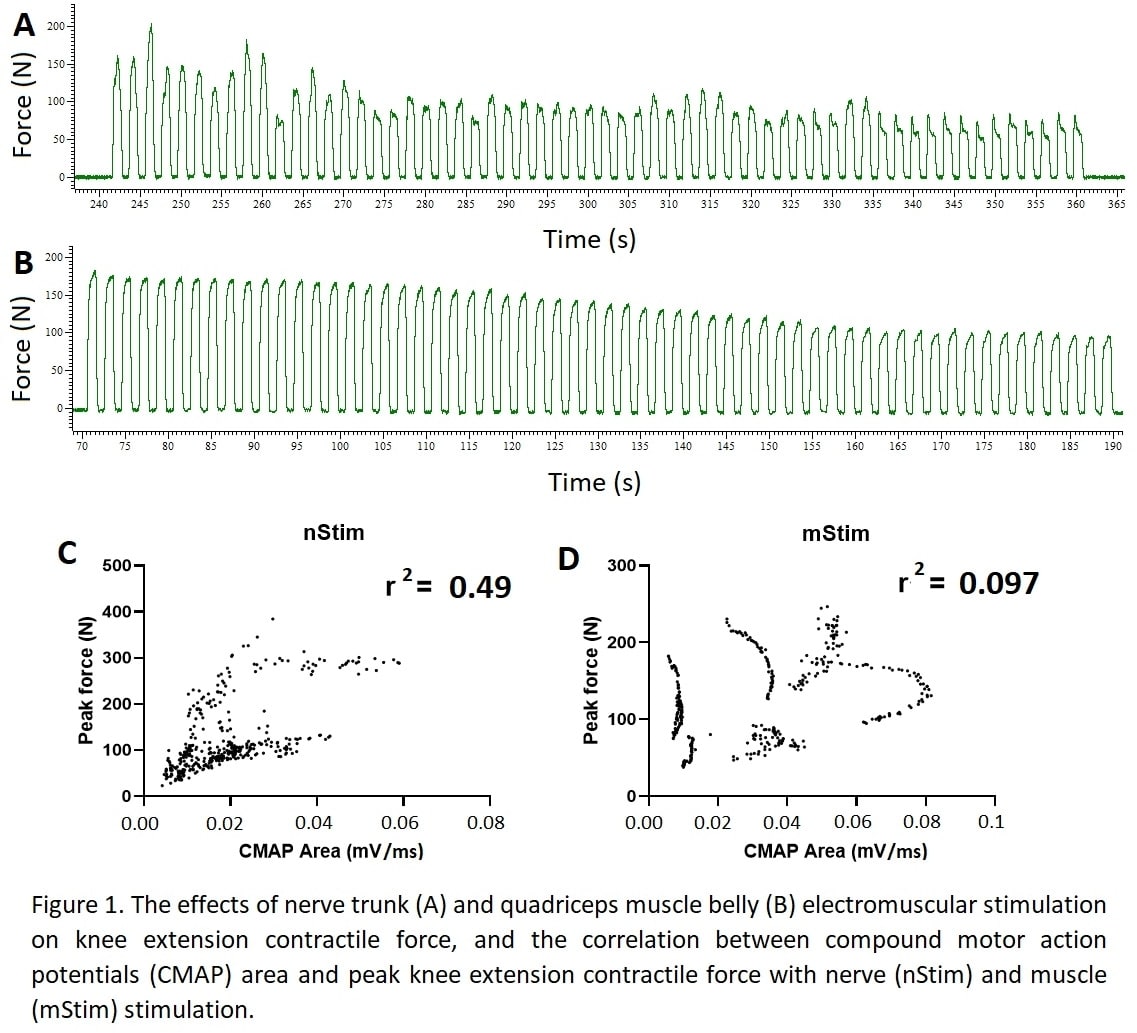Electromuscular stimulation (EMS) has been employed as an interventional strategy to mitigate the deleterious effects of age on neuromuscular function (Kern et al., 2014). However, studies using EMS use variable protocols and to date, show inconsistent results (Trethewey et al., 2019). One previous study compared EMS over the quadriceps muscle belly versus over the femoral nerve and reported greater central pathway recruitment with nerve stimulation, compared to greater peripheral recruitment with muscle stimulation (Bergquist, Wiest and Collins, 2012). However, the effects of each method on inducing muscle fatigue are unclear, and there is a need to develop consistent EMS intervention protocols that target the large, functionally important lower limb muscle groups, such as the quadriceps. Seven young (27±3 y), healthy participants were recruited to this study. In session 1, EMS was applied via the femoral nerve (nStim), followed by application via the muscle belly (mStim) >48h later. For nStim, stimulating electrodes were placed on the lower back and over the femoral nerve. mStim involved the electrodes being placed over the quadriceps muscle belly. For each modality, a single 30Hz stimulus was applied, with sufficient current to achieve involuntary contractile force equivalent to 30% maximal voluntary isometric contraction (MVC). The electrically stimulated intermittent contraction fatigue test (McPhee et al, 2014) was then applied to the quadriceps (60 stimuli at 30Hz with a predetermined current (Figure 1A/B). MVC was assessed pre and post fatigue test, with vastus lateralis compound motor action potentials (CMAP) measured throughout to provide an estimate of electrophysiological activity. Isometric force generated by voluntary and involuntary contractions were recorded using Spike2 software (Cambridge Electronic Design) while the participant was seated in a chair fixing the knee at 90°. Tolerance of each protocol was assessed using a visual analogue scale. nStim and mStim induced muscle fatigue to a similar extent with similar reductions in both MVC (14±9% and 16±10%, both P<0.01) and involuntary force (46±20%, P<0.01 and 41±8%, P<0.001, respectively). The coefficient of variation for mean involuntary peak contraction force was higher for nStim (28±11%) compared to mStim (19±4%). Correlation of mean CMAP area versus peak contraction force was r2=0.49 (P<0.001) for nStim, and r2=0.097 (P<0.001) for mStim (Figure 1C/D). There was no significant difference between self-reported discomfort in mStim versus nStim (6.3±1.9 vs. 3.8±2.1, P=0.09). Both forms of EMS are able to induce muscle fatigue to a similar extent. The greater variability in force production observed with nStim may reflect a more variable pool of recruited motor units. Force produced via nStim was highly correlated with electrophysiological activity, and as such may be a useful indicator of muscle activity where force recording is not possible.
Physiology 2019 (Aberdeen, UK) (2019) Proc Physiol Soc 43, PC127
Poster Communications: Electrical stimulation via the motor nerve may recruit from a more variable motor unit pool than direct muscle stimulation
T. B. Inns1, D. McCormick1, B. Phillips1, M. Piasecki1
1. School of Medicine, MRC-ARUK Centre for Musculoskeletal Ageing Research, University of Nottingham, Derby, United Kingdom.
View other abstracts by:
Where applicable, experiments conform with Society ethical requirements.

